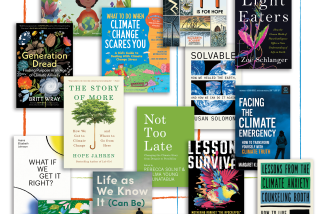Deep Ecology: Living as if Nature Mattered,...
Deep Ecology: Living as if Nature Mattered, Bill Devall, George Sessions (Peregrine Smith: $9.95). Former Interior Secretary James Watt might have convinced this nation otherwise, but the environmental cause in the United States indeed has gained ground since the 1960s: Political lobbying groups have consolidated power; new, pro-conservation legislation has been passed; and an emerging group of socially liberal young professionals “turned on” to high-tech believes it has reconciled the need for industrial growth with the necessity of protecting the biosphere. For environmentalists, it seems, the time has come to compromise.
Viewed in this light, “Deep Ecology,” arguing that the environmental crisis won’t be solved “within the confines of conventional political processes,” seems out of touch. But that impression will last only momentarily for readers who venture through this 1985 work, as the authors do an effective job of illustrating just how constricting those “confines” can be. As things stand now, the authors contend, environmentalists are unable to mitigate long-term damage caused by environmental exploitation. Instead, activists must combat “fresh horrors almost daily. They research the extent of each new life-threatening situation, rush to protest it, and campaign exhaustively to prevent a future occurrence. It’s a valuable service, of course, but imagine a hospital that consists only of an emergency room. No maternity care, no pediatric clinic, no promising therapy, just mangled trauma cases.” The emergence of “New Age” political pros won’t help either, the authors write, because while these leaders are savvy about “Spaceship Earth,” they still think nature exists only to serve man. The authors’ critique is convincing, though the same cannot be said of their solution. Their goal is only vaguely defined (“the cultivation of ecological consciousness”) and the political model they endorse (“consensus democracy”) has not yet proved viable.
The Wrong Case, James Crumley (Vintage: $5.95). No sooner has Milo decided he’s through with routine private-eye cases than Helen walks in, timidly asking the ex-county deputy to find her little brother. Milo is not interested in her brother, but looking at the vulnerable, pretty young woman, he takes on the case, certain that he’ll have found the missing person by nightfall. This 1975 book, however, is a mystery, critically acclaimed for successfully following in the tradition of Raymond Chandler, and so the brother remains out of sight, clearing center stage for drugs, scandal--and murder.
Gas, Food and Lodging, John Baeder (Abbeville: $16.95). It was easier to discover America in the 1930s and ‘40s. While today’s travelers, exiting a superhighway, are likely to come across a predictable cluster of chain-run fast-food outlets, those pulling off the road half a decade ago could enter a fish-shaped drive-in, a gas station with a B-17 aircraft fueling up on top, or see “The Grand Canyon Trading Post,” a wooden monument for tourists that seems to have emerged from a sci-fi thriller, not an Indian tribe.
Drawing from photographs, postcards and letters sent home during the era, John Baeder re-creates the time when the gas station was an oasis, not an eyesore, when roadside entrepreneurs paraded their eccentricity with enthusiasm, if not flair: “This is the laughing gas station,” reads one billboard spanning the length of a dusty filling station, “Where we sell gasoline and oil and take your money with a smile/old rokefeller made his pile and maybe we will afterwhile.”
Letters to Apprentices; Letters to Architects, Frank Lloyd Wright, selected and with commentary by Bruce Brooks Pfeiffer (California State University, Fresno: $8.95 and $9.95). To say that Frank Lloyd Wright wanted to reshape the world, these letters reveal, is not to overstate the point. Until his death in 1959 at age 90, Wright worked to place man in harmony with the features of the landscape. Neither of these books reveal much about how Wright realized that goal through the discipline he created, Organic Architecture. Instead, the letters are at the same time esoteric--conveying Wright’s thoughts about placing man in harmony with nature--and practical--reflecting the architect’s concern about the failing health of friends and precarious finances at Taliesin, the learning institute he created.
Because of their preoccupation with the practical, not all of the pieces in “Letters to Apprentices” are “witty, wise, wistful (and) devastating,” as the jacket cover would have us believe. Nevertheless, they show how Wright’s desire to help middle-income Americans design their own environment was mirrored by his conviction that talented, poor students be admitted to Taliesin. “Letters to Architects” offers photos of Wright’s work and Wright’s thoughts on why “we’ve got the kind of buildings we deserve. . . . If we were to wake up and take a good look at ourselves, as ourselves-- without trying to pass the buck--without trying to blame other people for what really is our own shortcoming and our own lack of character, we would be an example to the world that the world needs now.”
NOTEWORTHY: Illiterate America, Jonathan Kozol (New American Library: $6.95). In “Death at an Early Age,” the author showed how illiteracy can cripple a generation; here, he looks at the latest damage and suggests a solution. The Soviet Novel: History as Ritual, Katerina Clark (University of Chicago: $11.95) takes Socialist Realism seriously as a literary and cultural tradition in its own right rather than offering the usual, acerbic commentary. The Mighty Endeavor: The American War in Europe, Charles B. MacDonald (Morrow: $14.95). Praised when it first appeared in 1969, the book focuses on the inner workings of the U.S. military establishment and on strategy-making in the European theater during World War II. None of the Above: Behind the Myth of Scholastic Aptitude, David Owen (Houghton Mifflin: $7.95) succeeds in showing that the SAT, the nation’s most popular college entrance exam, is at best an arbitrary indicator of intelligence.

